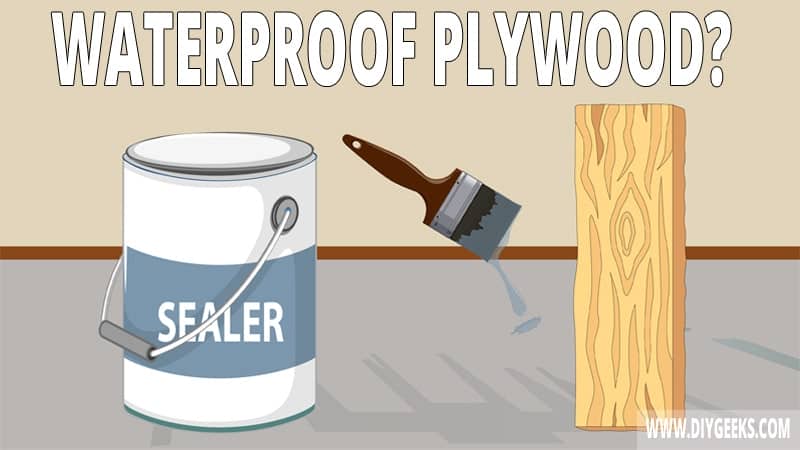Plywood is a synthetic wood type made from gluing wood veneer thin sheets together.
To waterproof plywood, use polyurethane varnish, epoxy sealers, or water sealers. These sealers will create a moisture-resistant layer (or barrier) and protect the plywood from water, moisture, scratches, and weather elements.
Why Should You Waterproof Plywood?
You should waterproof plywood to protect it against water damage, make it more weather-friendly, improve its beauty and luster, and prevent mold.
1. Prevent it Against Water Damage
Water can damage a plywood material as the plywood has a synthetic formula and is layered veneer sheets that can’t withstand high water amounts.
If the plywood is exposed to constant water, the water penetrates its material and causes the sheets to swell and weakens the board adhesive, making the sheets become delaminated.
Water causes the plywood material to eventually become waterlogged and start to rot. Waterproofing plywood will protect it from moisture and water damage and help the material last longer without getting waterlogged.
2. Makes It More Weather Friendly
Waterproofing plywood makes the material more weather-friendly and helps it withstand weather elements (such as rain, UV, or snow) better.
3. Improves Its Beauty and Luster
A waterproof sealer can give the plywood surface more luster (sheen) and improve its appearance by highlighting the surface texture and patterns.
4. Prevents Mold
A waterproof sealer can prevent mold growth over the plywood surface as it prevents water, moisture, and dust from penetrating the material.
Which Sealers Can You Use to Waterproof Plywood?
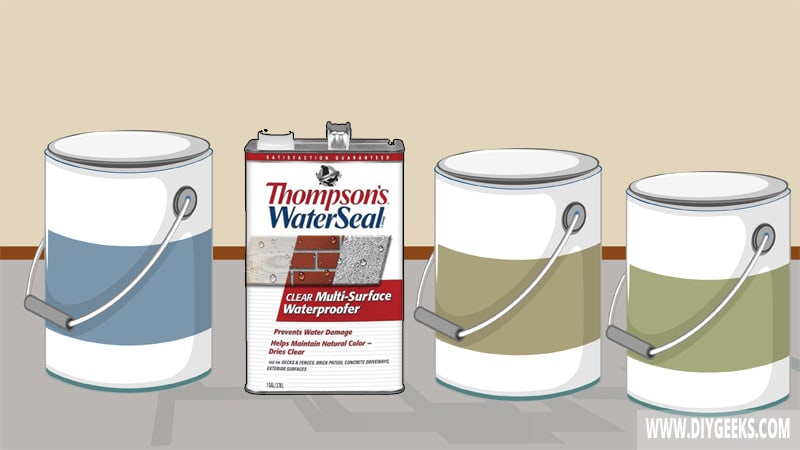
The sealers you can use to waterproof plywood are listed below.
- Polyurethane Varnish
- Epoxy Sealer.
- Water Sealers.
- Waterproof Paint.
1. Polyurethane Varnish
- Polyurethane varnish creates a transparent (or colored) glossy moisture-resistant coating over the surface and protects it from water, moisture, and scratches.
- It creates a plastic-like finish that prevents water or moisture penetration and is flexible enough to contract and expand based on temperature changes.
- Polyurethane varnish advantages are listed below.
- It protects plywood against moisture and rainfall.
- Prevents mold growth.
- Exterior polyurethane is heat and UV-resistant.
- Easy to apply.
- Polyurethane varnish disadvantages are listed below.
- Long dry and cure time.
- No color (transparent finish).
2. Epoxy Sealer
Epoxy sealer is a sealer type formulated with epoxy resins that create a transparent protective coating that protects surfaces from water, moisture, scratches, and weather elements.
Most epoxy sealers come in two parts that must mix together — the polymer and the curing agent. Epoxy sealers have a semi-gloss or high-gloss finish that highlights the underlying surface texture and patterns.
Epoxy sealer advantages are listed below.
- Protects plywood from high moisture levels and rainfall.
- Creates a transparent layer over the surface.
- Makes the surface weather-resistant in addition to being waterproof.
- It gives a colorful finish as epoxy also comes in tinted colors.
Epoxy sealer disadvantages are listed below.
- Since it needs to be poured or wiped on, epoxy is difficult to apply on vertical surfaces.
- Long Dry Time.
3. Water Sealer
Water sealers create a protective and durable finish that prevents water from penetrating the underlying surface. They are usually formulated with synthetic resins, solvents, plasticizers, and protective additives.
You can apply water sealers with a sprayer, or brush, or wipe them over the surface as they have a fast dry time.
Some water sealers type penetrate the plywood surface to make it waterproof from the inside, while some types stay over the top layer and form a water-resistant layer over it.
We recommend using Thompson’s water sealer.
Water sealer advantages are listed below.
- Easy to apply.
- Suited for interior and exterior usage.
- Fast dry time.
Water sealer disadvantages are listed below.
- Not as durable as epoxy sealers.
4. Waterproof Paint
Waterproof paints are paint types formulated with extra protective additives that create a moisture-resistant layer over the surface and protect it from water, moisture, and weather elements.
Most waterproof paints create a colorful high-gloss finish that covers the surface patterns. They are applied the same way normal paint types are applied.
Waterproof paint advantages are listed below.
- Different color shades and finish types.
- Fast dry time.
- They are easy to apply.
Waterproof paint disadvantages are listed below.
- Expensive
- Won’t give you a natural wood finish because of the color pigments in its formula.
Which Sealer Types You Shouldn’t Use To Waterproof Plywood?
The sealer types you shouldn’t use to waterproof plywood are listed below.
- Rust-oleum Spray Paint.
- Wood Oils.
- Sanding Sealers.
1. Rust-Oleum Spray Paint
Rust-oleum is a waterproof spray paint designed for metal and aluminum surfaces, and not plywood surfaces.
2. Wood Oils
Wood oils are natural or synthetic finishes that create a semi-moisture-resistant coating and protect surfaces from low water and moisture amounts. However, wood oils are designed for natural woods and not synthetic wood, such as plywood.
3. Sanding Sealers
Sanding sealers are undercoats applied over surfaces to cover (or fill) the pores and prevent paint wastage. You shouldn’t use sanding sealers to seal plywood from water as they don’t offer water protection.
How to Waterproof Plywood?
To waterproof plywood, do the following things.
- Use Polyurethane.
- Use Epoxy Sealer.
- Use Water Sealer.
The tools you need for this project are listed below.
- A drop sheet
- Masking tapes
- Polyurethane
- Paintbrushes or a paint sprayer
- Wood filler
- A plastic putty knife
- A pair of work gloves
- Sandpaper
- Clean rags
- A portable vacuum or duster
1. Use Polyurethane Varnish
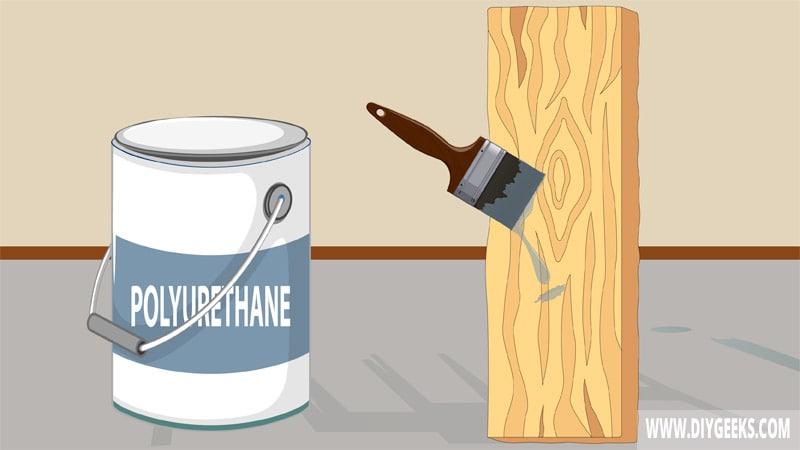
You can use polyurethane for interior and exterior plywood surfaces. Use water-based polyurethane for interior plywood, and oil-based or exterior polyurethane for exterior plywood.
Here’s how to use it:
- Prepare your work area by removing items and furniture on and around the surface.
- Fill holes in the plywood with wood filler.
- Clean the surface with a lint-free rag and mineral spirits to remove grease and oily scum – if it’s a new plywood structure, you can skip this step.
- Leave the plywood to dry and sand it with fine-grit sandpaper (220-grit).
- Apply an undercoat or paint if needed and allow it to dry (you can skip this step if you want to apply the polyurethane directly)
- Seal the plywood surface with 3 polyurethane coats. Wait until one coat dries before applying the next one.
- Cover the edges and bottom of the surface with equal parts of polyurethane. This ensures the entire plywood is waterproof and not just the surface.
- Allow the sealer to dry for 3 days before normal usage is resumed.
Tip: Polyurethane only gives a transparent finish so if you want a color finish, ensure to mix the polyurethane with wood dye or acrylic paint, or use tinted polyurethane before application.
2. Use Epoxy Sealer
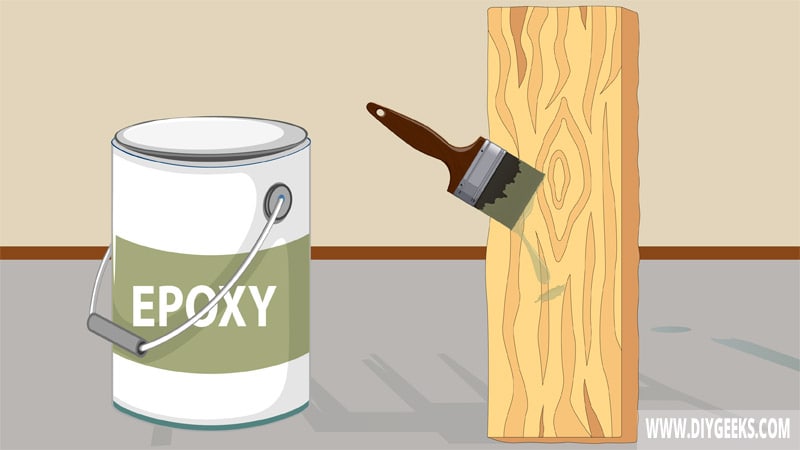
You can seal interior and exterior plywood surfaces with epoxy sealers. Since epoxy sealer has a thick viscosity, wipe it over the plywood instead of spraying it.
Here’s how to use it:
- Prep the surface by removing all objects.
- Repair the plywood by filling holes and gouges with wood filler.
- Sand down the surface and edges.
- Apply primer or paint.
- Apply the first coat of epoxy sealer using a paintbrush, cloth, or roller.
- Leave the first coat to dry for 2 hours.
- Scuff the first coat with 400-grit sandpaper.
- Apply two more coats and allow the epoxy sealer to dry fully.
3. Use Water Sealer
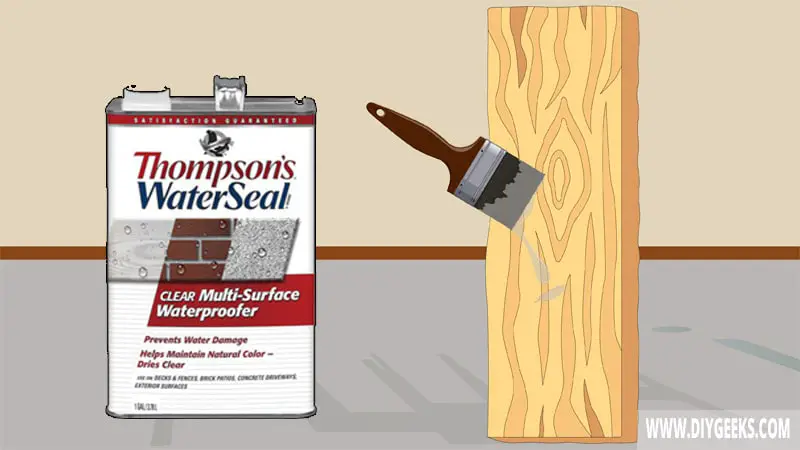
Use a water sealer, such as Thompson’s Waterseal, to seal interior and exterior plywood surfaces. You can use waterproof paint if you don’t have a water sealer.
Here’s how to use it:
- Wipe down the surface with mineral spirits to ensure it’s clean.
- Sand the surface with 220-grit sandpaper and remove dust.
- Prep the water sealer – usually, you need to shake the water sealer container to prep it. For waterproof paint, you’ll need to shake or stir the content depending on the type you have.
- Use a paintbrush or paint sprayer to apply the first coat of water sealer and leave it to dry.
- When the first coat is dry, apply the second coat and leave it to dry. Usually, you only need two coats of water sealer but for waterproof paints, you can apply up to 3 coats.
- Test the finish when dry to know if you need another coat.
You can waterproof all types of interior plywood boards as they are designed for looks and not durability or moisture resistance. So, you can waterproof them using any of the methods explained above. The most common types of plywood for interior designs are BWR/BWP ply, Marine ply, and MR-grade plywood.
Are There Waterproof Plywoods?
Exterior plywoods are designed to be waterproof and repel water as they are reinforced with extra protective additives and are thicker.
Unlike interior plywood surfaces that are designed to show designs and beauty, exterior plywood reveals blemishes and knots.
The most common exterior plywood types are CDX-grade, Pressure-treated grade, and some Marine-grade plywood. Their surfaces are designed to thrive when exposed to moisture, but you can still waterproof them to improve their moisture resistance.
